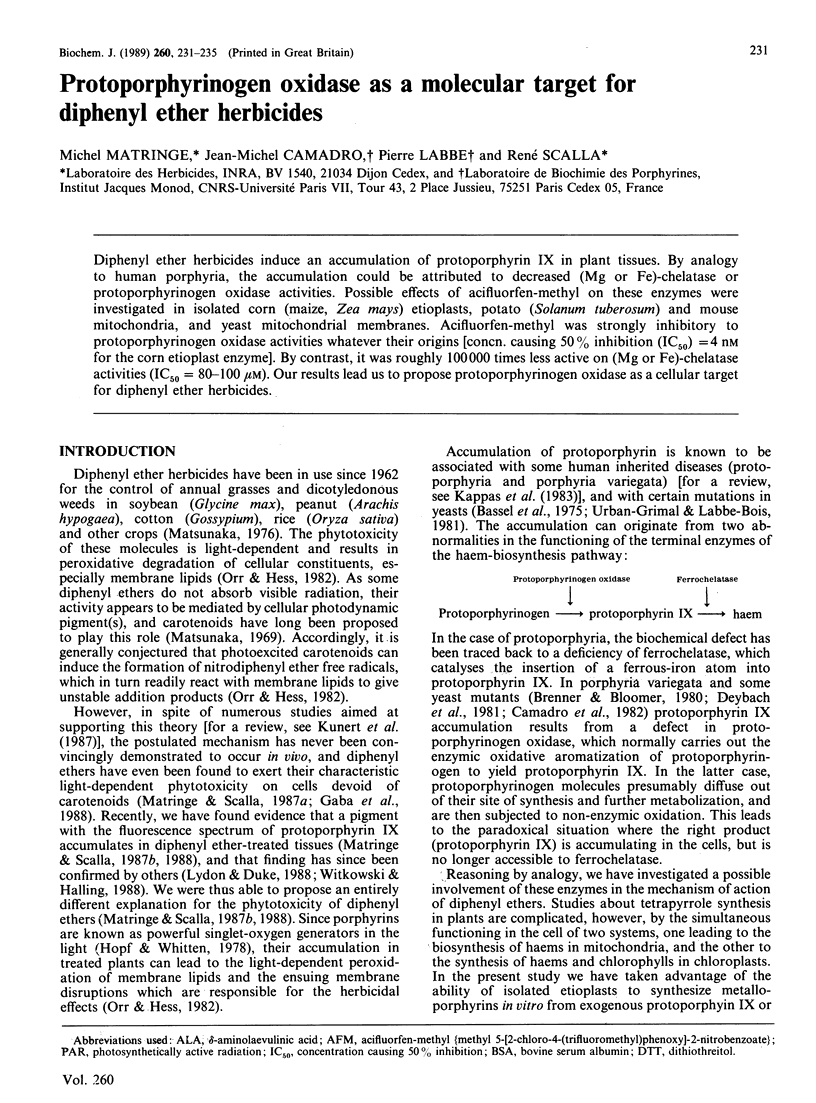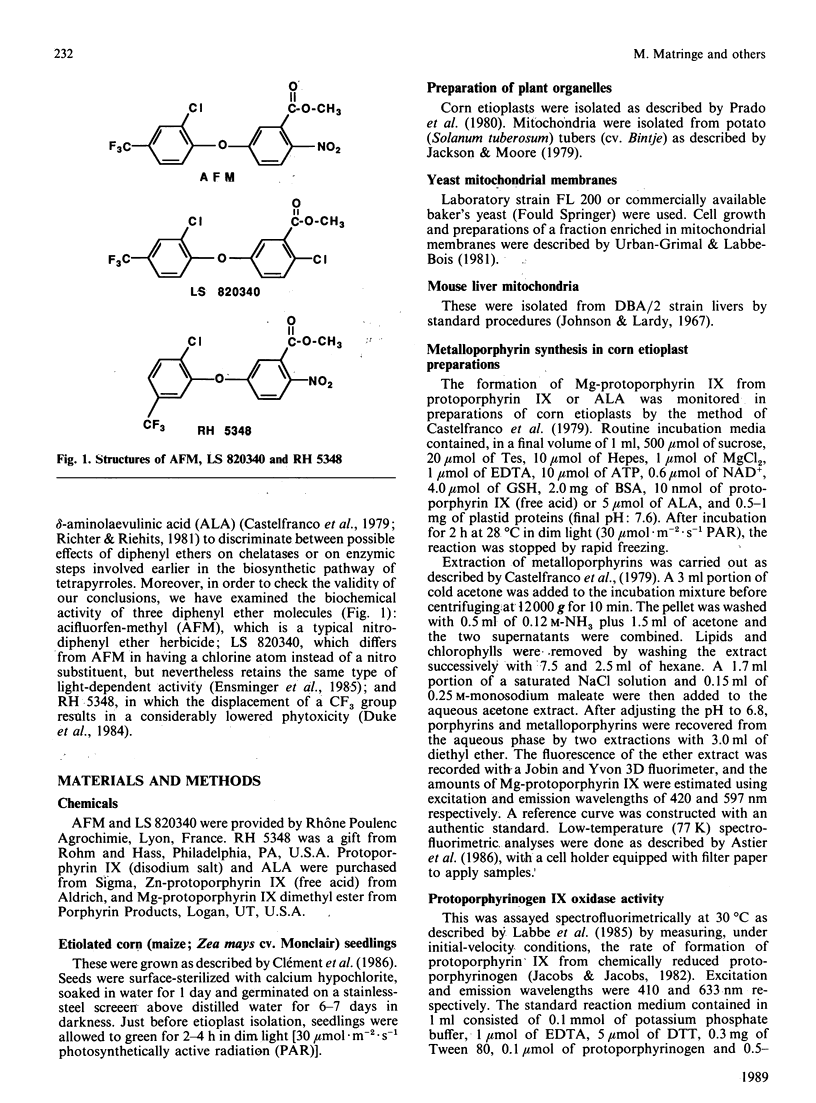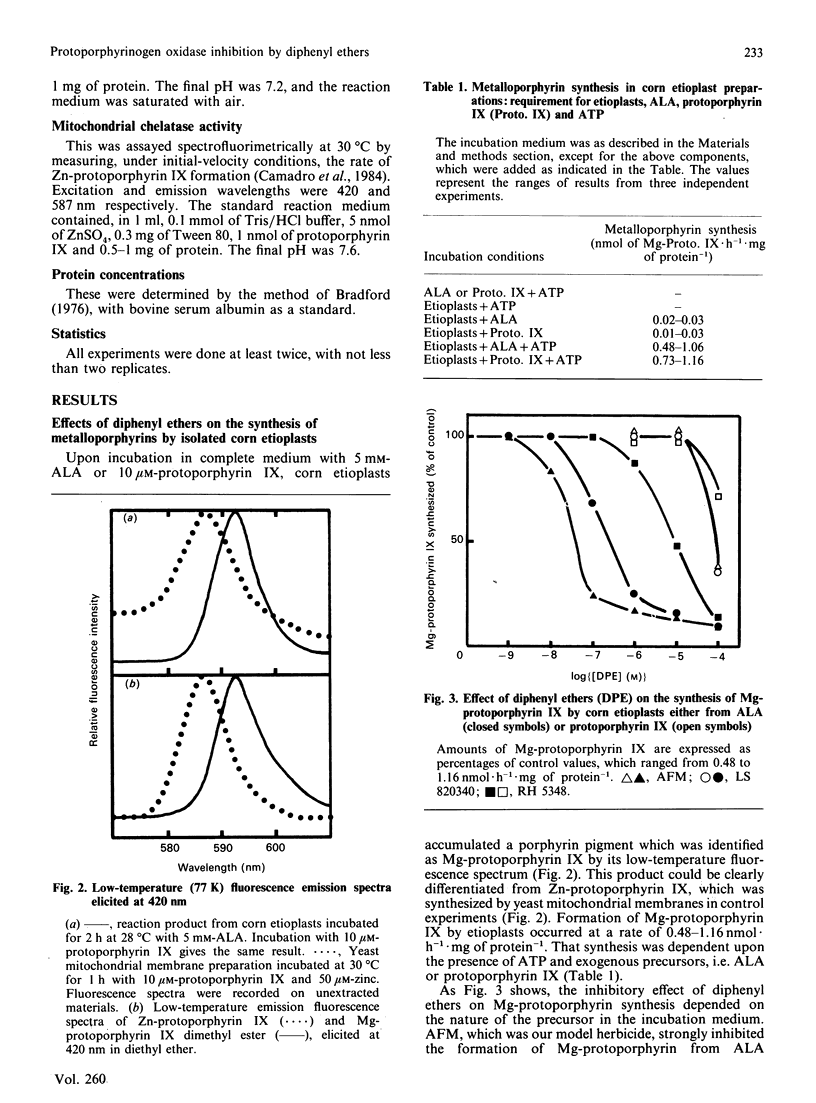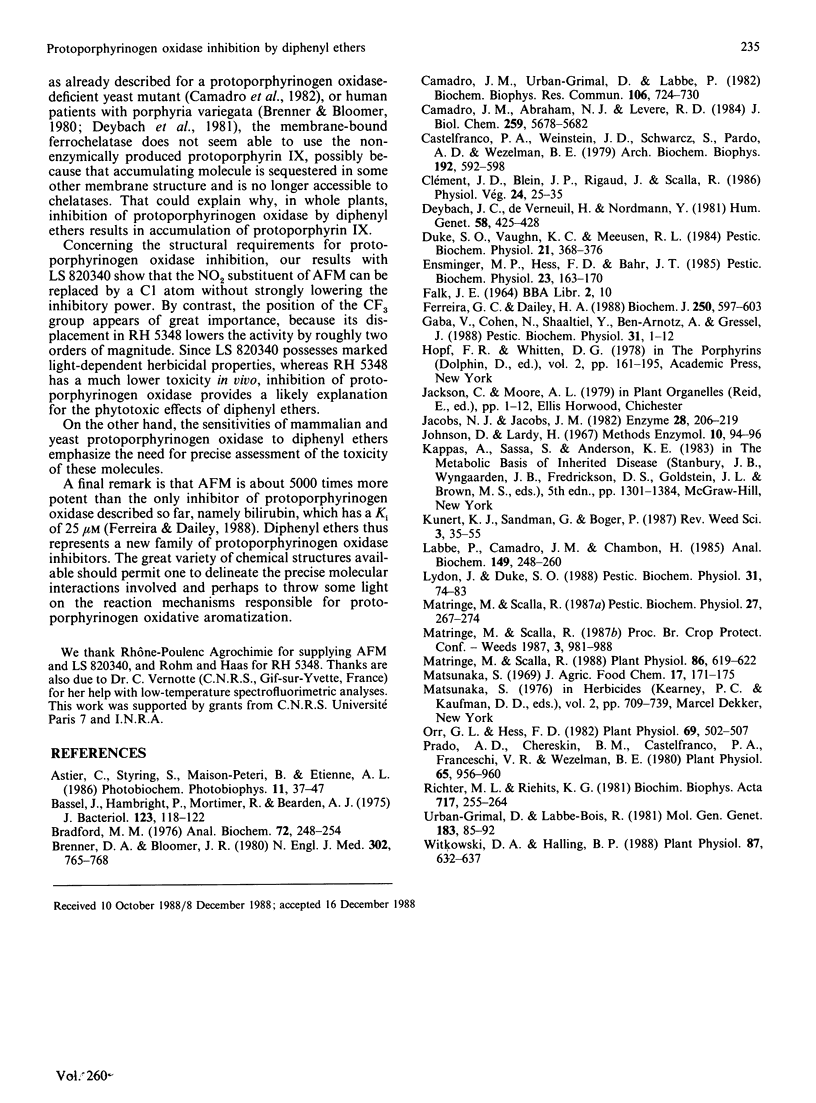Abstract
Diphenyl ether herbicides induce an accumulation of protoporphyrin IX in plant tissues. By analogy to human porphyria, the accumulation could be attributed to decreased (Mg or Fe)-chelatase or protoporphyrinogen oxidase activities. Possible effects of acifluorfen-methyl on these enzymes were investigated in isolated corn (maize, Zea mays) etioplasts, potato (Solanum tuberosum) and mouse mitochondria, and yeast mitochondrial membranes. Acifluorfen-methyl was strongly inhibitory to protoporphyrinogen oxidase activities whatever their origins [concn. causing 50% inhibition (IC50) = 4 nM for the corn etioplast enzyme]. By contrast, it was roughly 100,000 times less active on (Mg or Fe)-chelatase activities (IC50 = 80-100 microM). Our results lead us to propose protoporphyrinogen oxidase as a cellular target for diphenyl ether herbicides.
Full text
PDF




Selected References
These references are in PubMed. This may not be the complete list of references from this article.
- Bassel J., Hambright P., Mortimer R., Bearden A. J. Mutant of the yeast Saccharomycopsis lipolytica that accumulates and excretes protorphyrin IX. J Bacteriol. 1975 Jul;123(1):118–122. doi: 10.1128/jb.123.1.118-122.1975. [DOI] [PMC free article] [PubMed] [Google Scholar]
- Bradford M. M. A rapid and sensitive method for the quantitation of microgram quantities of protein utilizing the principle of protein-dye binding. Anal Biochem. 1976 May 7;72:248–254. doi: 10.1006/abio.1976.9999. [DOI] [PubMed] [Google Scholar]
- Brenner D. A., Bloomer J. R. The enzymatic defect in variegate prophyria. Studies with human cultured skin fibroblasts. N Engl J Med. 1980 Apr 3;302(14):765–769. doi: 10.1056/NEJM198004033021401. [DOI] [PubMed] [Google Scholar]
- Camadro J. M., Ibraham N. G., Levere R. D. Kinetic studies of human liver ferrochelatase. Role of endogenous metals. J Biol Chem. 1984 May 10;259(9):5678–5682. [PubMed] [Google Scholar]
- Camadro J. M., Urban-Grimal D., Labbe P. A new assay for protoporphyrinogen oxidase - evidence for a total deficiency in that activity in a heme-less mutant of Saccharomyces cerevisiae. Biochem Biophys Res Commun. 1982 Jun 15;106(3):724–730. doi: 10.1016/0006-291x(82)91771-5. [DOI] [PubMed] [Google Scholar]
- Castelfranco P. A., Weinstein J. D., Schwarcz S., Pardo A. D., Wezelman B. E. The Mg insertion step in chlorophyll biosynthesis. Arch Biochem Biophys. 1979 Feb;192(2):592–598. doi: 10.1016/0003-9861(79)90130-9. [DOI] [PubMed] [Google Scholar]
- Deybach J. C., de Verneuil H., Nordmann Y. The inherited enzymatic defect in porphyria variegata. Hum Genet. 1981;58(4):425–428. doi: 10.1007/BF00282829. [DOI] [PubMed] [Google Scholar]
- Ferreira G. C., Dailey H. A. Mouse protoporphyrinogen oxidase. Kinetic parameters and demonstration of inhibition by bilirubin. Biochem J. 1988 Mar 1;250(2):597–603. doi: 10.1042/bj2500597. [DOI] [PMC free article] [PubMed] [Google Scholar]
- Jacobs N. J., Jacobs J. M. Assay for enzymatic protoporphyrinogen oxidation, a late step in heme synthesis. Enzyme. 1982;28(2-3):206–219. doi: 10.1159/000459103. [DOI] [PubMed] [Google Scholar]
- Labbe P., Camadro J. M., Chambon H. Fluorometric assays for coproporphyrinogen oxidase and protoporphyrinogen oxidase. Anal Biochem. 1985 Aug 15;149(1):248–260. doi: 10.1016/0003-2697(85)90502-0. [DOI] [PubMed] [Google Scholar]
- Matringe M., Scalla R. Studies on the mode of action of acifluorfen-methyl in nonchlorophyllous soybean cells : accumulation of tetrapyrroles. Plant Physiol. 1988 Feb;86(2):619–622. doi: 10.1104/pp.86.2.619. [DOI] [PMC free article] [PubMed] [Google Scholar]
- Orr G. L., Hess F. D. Mechanism of Action of the Diphenyl Ether Herbicide Acifluorfen-Methyl in Excised Cucumber (Cucumis sativus L.) Cotyledons : LIGHT ACTIVATION AND THE SUBSEQUENT FORMATION OF LIPOPHILIC FREE RADICALS. Plant Physiol. 1982 Feb;69(2):502–507. doi: 10.1104/pp.69.2.502. [DOI] [PMC free article] [PubMed] [Google Scholar]
- Pardo A. D., Chereskin B. M., Castelfranco P. A., Franceschi V. R., Wezelman B. E. ATP requirement for mg chelatase in developing chloroplasts. Plant Physiol. 1980 May;65(5):956–960. doi: 10.1104/pp.65.5.956. [DOI] [PMC free article] [PubMed] [Google Scholar]
- Urban-Grimal D., Labbe-Bois R. Genetic and biochemical characterization of mutants of Saccharomyces cerevisiae blocked in six different steps of heme biosynthesis. Mol Gen Genet. 1981;183(1):85–92. doi: 10.1007/BF00270144. [DOI] [PubMed] [Google Scholar]
- Witkowski D. A., Halling B. P. Accumulation of photodynamic tetrapyrroles induced by acifluorfen-methyl. Plant Physiol. 1988 Jul;87(3):632–637. doi: 10.1104/pp.87.3.632. [DOI] [PMC free article] [PubMed] [Google Scholar]


